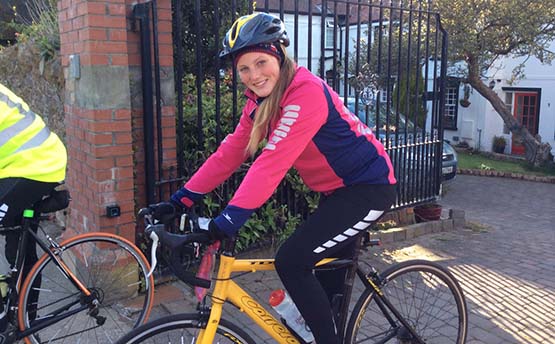Displaying items by tag: Howth Yacht Club
Howth Yacht Club Marks 120th Anniversary With Gala Ball & Aoife Hopkins Fundraiser
Next month marks Howth Yacht Club's 120th anniversary and the north Dublin club are marking the important occasion with an inaugural 'Boyd Ball' on Saturday the 14th November.
The dinner will be a black tie affair and commences with a Commodore's drinks reception at 19:30, 'celebrity' pianist during dinner, after-dinner entertainment by local 'Apres Match' impressionist comedian Gary Cooke and the 'Savage Eye's' John Colleary. The night will conclude following live music and dancing.
This entertainment-filled night will also contribute to the fundraising campaign of Howth's own Aoife Hopkins, as she strives to qualify for the 2016 Olympic Games in Rio de Janerio.
Aoife's Special Sailing Talent Points Howth Towards The Olympics
With a disappointing showing by the Irish squad in the pre-Olympic Regatta in Rio in August, hopes are not high for our performance in the 2016 Sailing Olympics at this light wind city venue, which has already been the subject of heated debate about the specific racing locations, and the water quality. W M Nixon takes up the story, and looks at the possible new turn in the Irish lineup.
World sailing (which as it happens, is what ISAF is going to become in a couple of weeks time) needs the Olympic Games rather more than the Olympic Games need sailing. Such is the extraordinary international appeal of the five ring circus, as it rolls remorselessly along through its four year cycle, that other more spectator-friendly but currently non-Olympic sports are ready and waiting to take over sailing’s small space in this global sporting showcase, and they’ll do so if sailing is perceived as not delivering the Olympic goods in television audience response, in spectators trying to see the racing, and in its global spread of participants.
The smaller specialist sports still outside the huge Olympic tent know only too well that it’s their one opportunity for a place in the international limelight, and on a scale which they can never hope to attain if they try to continue as a minority interest simply getting on with doing its own thing.
Of course, for many sailing and boating folk, as for enthusiasts in other specialist sports, simply getting on with doing their own small thing is what it’s all about. The Olympics is something in which they might take a polite interest, but only when the Olympiad itself is taking place.
But for those involved with running national sporting authorities, the publicity and prestige which Olympic involvement brings, plus the capacity it confers on national sporting administrators to deal with government and national agencies on basis of equality, rather than as some lowly supplicants seeking meagre support, gives the Olympics huge importance.
 The old ideal of Olympic Sailing was that it should be in open water clear of shoreside imbalances. This is Ireland’s Annalise Murphy at Day 3 of the 2012 Olympics off Weymouth, when the races were still being held in open water in good breezes, and the Irish sailor was in contention for the Gold medal.
The old ideal of Olympic Sailing was that it should be in open water clear of shoreside imbalances. This is Ireland’s Annalise Murphy at Day 3 of the 2012 Olympics off Weymouth, when the races were still being held in open water in good breezes, and the Irish sailor was in contention for the Gold medal.
At a world level, it means that when an Olympic venue city has been selected, international sailing is obliged to swallow its pride (and probably some decidedly polluted sailing water as well), and accept that wherever in its bailiwick the host city has decided that the sailing events should be staged for maximum spectator and civic impact, then that is definitely where the Olympic Sailing is going to be, regardless of how much huffing and puffing some sailing perfectionists might make beforehand.
For the fact is, most major and participant-popular sailing venues are not anywhere near the heart of some great but water-polluted city. But ever since their inception - or rather their re-invention - the Olympic Games in modern times have been allocated to a city. And though in times past the sailing may have been held at some remote location to provide decent sport – as it was at Weymouth when the Games were in London in 2012, and even then it was distorted with the Medal Races staged much too close to the shore – the Rio de Janeiro situation with the sailing more or less in the heart of town is definitely the way the city fathers are determined to go.
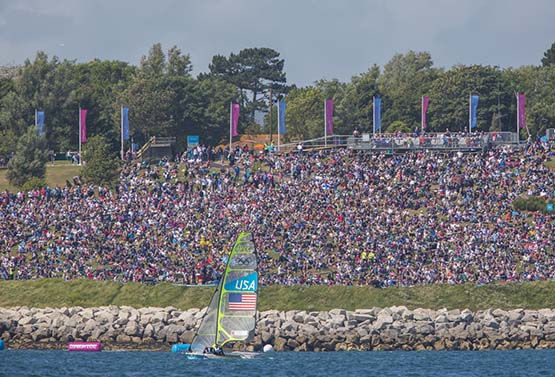
The final races at Weymouth in 2012 were held close inshore. This is the way hosting cites would like to see the Sailing Olympics develop, but it facilitates spectators rather than participants.
Yet despite these obviously painful compromises which have had to be made, such is the kudos which the Olympics bring to any sport that in any country, and most particularly in a small country, that the Olympics loom over everything else like some remote yet all-powerful and voracious monster which has to be fed and generally appeased
And of all sports in all countries, it is probably sailing in Ireland which is most affected by this situation. In the international community afloat, Ireland is recognised as punching way above its weight as a sailing nation. But we’re a small country in every other way, and within Ireland itself, sailing has to compete with a range of many and varied sports in a sports-mad place which, while it may be an island, is basically so utterly rural or completely urban in its attitudes that the only time sailing comes up on the public radar is when it’s on in the Olympics – and doing well – or when some great tragedy occurs, such as the Fastnet Race disaster of 1979.
As a result of this Olympo-reality, as we might call it, we have ended up with a national sailing authority which at first glance, seems more unbalanced the more we look at it. But should we describe the ISA’s situation as being unbalanced? Perhaps “realistic” is a better description. This is how it has to be. Whatever, when we analyse the money, we find a huge chunk of the ISA’s income is directed from the Government through the Sports Council more or less directly into the ISA’s High Performance squad, which has become a thriving mini-industry within a bureaucracy.
Follow the money, they say, and in this blog on August 8th on the topic of our team of hopefuls departing for the pre-Olympic regatta in Rio, while trying as gently as possible to warn that we expect far too much of our Olympic contenders, we also published figures which had been extracted for us by a forensic accountant from the ISA’s own published balance sheets. These showed just how much of the national sailing spend went directly into what is ultimately hoped to be Olympic standard sailing, and it was frankly scary.
What makes it even more scary is that it isn’t nearly enough, and with budgets being pared back left right and centre, while the staff on the High Performance squad may seem to enjoy remarkably high salaries and many attractive perks, by world standards they’re only just getting by. And as Irish amateur boxing has painfully shown this past week, if you don’t look after your Olympic coaches properly, some other nation will be only too pleased to do so instead.
But even with the supply of Sports Council money, the resources are largely limited to keeping the permanent staff in being and up to the job. The actual potential sailing athletes need much parental and other support, including direct sponsorship, if they’re going to be able to make best use of the expertise which is available from the training professionals. For the reality is that while you may be delighted that your son or daughter has risen through the sailing ranks to qualify for an ISA High Performance course, as the course progresses you can expect regular invoices, while going to events is something else which will also make a significant dent in the assets of the Bank of Mum & Dad.
But pure sailing talent is such a beautiful thing that we should give it all the support we can, and out to the northeast of Dublin there’s an impressive “Howth Can Do It” movement getting under way on the Peninsula to ensure that one of our own, 17-year-old Aoife Hopkins, gets all the support we can find in order to fulfill a remarkable talent which has developed prodigiously in recent months.
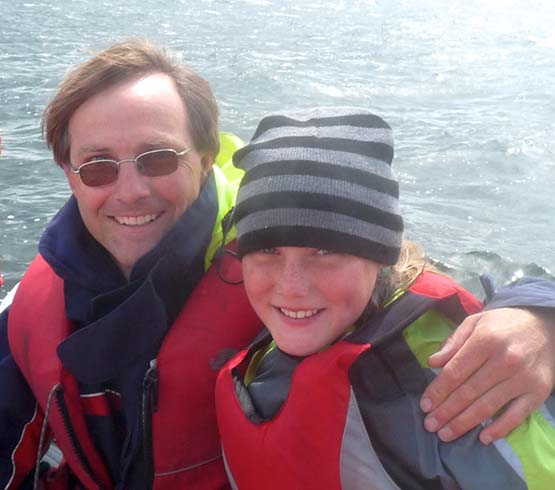
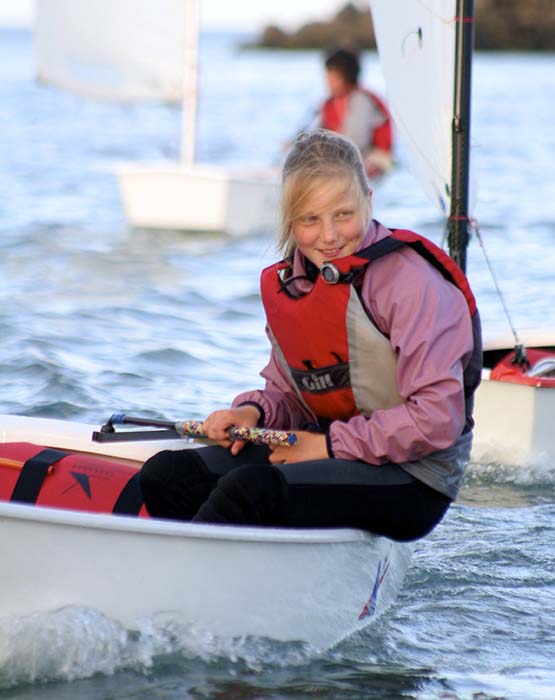
From being a child sailing star in the Spring of this year, Aoife in the Autumn finds herself with near-adult status despite having only recently turned seventeen. And it’s an adult status which has brought with it a rising world ranking in the Laser Women’s Radial class which entitles her to compete for the Irish place – already secured for us by 2012’s fourth-placed Olympian Annalise Murphy – in the Laser Women’s Radial class in the Rio Olympics next August.
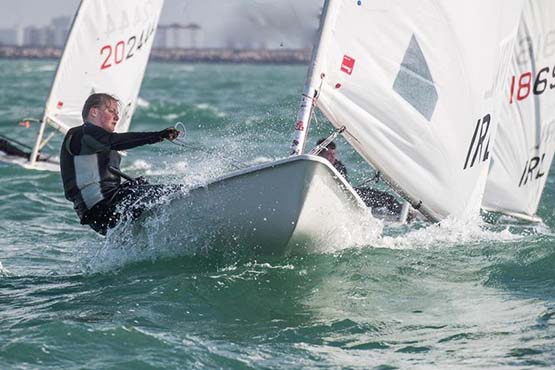

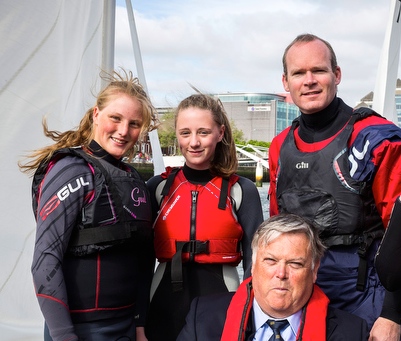 Her rapidly rising international status made Aoife (left) enough of a sailing celebrity to be recruited for the photo-op to promote the Try Sailing initiative with Minister for the Marine Simon Coveney (right) and John Twomey, World President of Disabled Sailing.
Her rapidly rising international status made Aoife (left) enough of a sailing celebrity to be recruited for the photo-op to promote the Try Sailing initiative with Minister for the Marine Simon Coveney (right) and John Twomey, World President of Disabled Sailing.
It’s an uncomfortably challenging scenario for Irish sailing. Annalise Murphy has served this country so very well, and so nobly, and will long continue to do so. But her exceptional heavy weather sailing abilities – which at one stage had her in the Gold Medal position in Weymouth in 2012 – have not provided a happy interaction with the light and flukey conditions which prevail in Rio in August.
Until a few weeks ago, the scenario was that the already identified talents of Aoife Hopkins were only under guidance towards the Tokyo Olympics of 2020. But after the setback of August, a different outlook began to take shape. Now that Hopkins was eligible to compete, if she could somehow continue her onward and upward rise through the remaining Olympic selector events towards Rio August 2016 - a three part international series which will conclude next March – and if she has actually got ahead of Murphy, why shouldn’t she go to Rio?
She’d still be only seventeen, but she’s so sensibly grounded with full family and community support that competing in the Olympics as a total newbie needn’t be an upsetting experience, whatever the result. And who knows, but it could even be surprisingly good. And anyway, so long as the longterm view is kept properly focused towards Tokyo where she will be an even more mature 21, then why not take in Rio on the way?
You can cast the runes any way you like, but meeting Aoife and her very supportive mother Niamh this week through the good offices of Howth Yacht Club Commodore Brian Turvey – a longtime supporter of the Hopkins cavalcade – gave me a remarkable insight into what could well be sailing history in the making.
Cometh the hour, cometh the woman…..Like all Ireland’s yacht and sailing clubs, after battling through a rather torrid economic time in recent years with 2012 being the absolute nadir, Howth is fairly leaping back to life. Our boats have gone back to winning here, there and everywhere, and if our popular Commodore says that there’s this girl who is emerging out of Howth sailing who really shows the extra special sort of talent which deserves full support in a very tangible way, then the membership – and indeed the entire Howth peninsula – is more than ready to give it all a favourable hearing.
Aoife’s track into sailing is interesting. Her father Troy is one of those hardy perennials who get afloat with the long-established Howth Laser winter series, but Aoife herself isn’t a cradle sailor. On the contrary, she was around nine when she started with an introductory course at Howth YC, but soon was hooked, and by age eleven she was gunning with her already proven determination for a place in the National Optimist Squad, which soon came her way, and life became one of Optimist fun and high-level competitive sport, morphing on into a year or so with Toppers, and then the Laser Radial where she soon felt at home.
The results have been impressive, but then we’ve had many young people who show great sailing promise, but somehow in their mid teens the interest wanes, and it’s unfair to everyone to try to keep them at it.
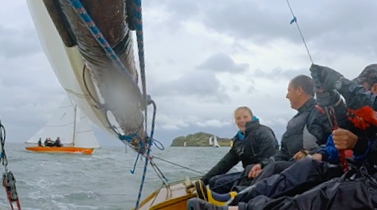
Aoife Hopkins continues to enjoy the more traditional aspects of Howth sailing – she is seen here helming the Howth 17 Isobelle to victory in this 118-year-old class’s annual Junior Race. In the Howth 17s, a “junior helm” is under the age of 30……..
But Aoife Hopkins and boats become something very special. She just lives for sailing, so much so that during 2015 she put in some weeks as an Instructor in the Junior Sailing Programme at HYC between campaigns which had already seen her making the cut in the Laser Radial Rankings, at the same time she found the space to race one of the J/80s which are now club-based in Howth, and when Brian Turvey asked her if she’d like to helm his classic Howth 17 in the Juniors Race, she leapt at the chance and won, even if somewhat bemused to find that in the 118-year-old Seventeens, a “Junior” is a helm under the age of thirty…..
Yet thanks to Howth being such a settled community with large networks of friends, she was by no means unhealthily boat-obsessed, and she still had the energy to do very well indeed in school (it’s Santa Sabina, alma mater to the girls of Howth) while her family were now getting steadily more involved with sailing.
In fact they must be unique in that in the Howth Laser Winter series, Aoife has been competing both with her father Troy and younger brother Daniel, and although mother Niamh is not a Laser sailor herself, she found herself doing so much of the class’s administration that she was elected the non-sailing Class Captain.

Beyond all that, there has been the growing international commitment, with some member of the family always available to travel in support of Aoife when she headed off for some distant major event. She and Niamh are more like a pair of sisters rather than mother and daughter as they recall various adventures in pursuit of international sailing competition, a special highlight being a drive by the pair of them right across Europe to Poland with the Laser on top of the family car, and success at the end of it.
At the moment, this extraordinary story of personal sailing development is at an exciting and entertaining early stage, and it’s still fun – it can cheerfully be admitted there was a healthy amount of laughter at this week’s meeting in the board-room atop Howth Yacht Club. But there’s no doubting the underlying seriousness of the challenge, and ideas for moving it forward were flying around in best kaleidoscope style.
At its most basic, the Aoife Hopkins campaign through the remaining three Olympic selector events will cost a minimum of €20,000, and it all has to be raised by Aoife and her family and supporters. But she has already made a very good start with her Crowd Funding project which was launched on Facebook with support from Afloat.ie and others, and within a week she’d raised €2000, which is ten per cent clear and counting.
Yet obviously there’s still much heavy lifting to be done, but in a club where the annual Christmas Charity Lunch managed to raise €20,000 for the late great sailor Joe English when his diagnosis of early-onset Alzheimers was revealed, €20,000 is very manageable, and Brian Turvey and his team would hope to have a comfortable margin beyond that.
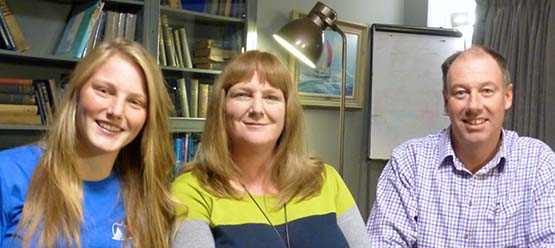
But as well, there can be supportive help in kind. Howth is a peculiar place in that people who live there but work in Dublin tend to discard their professional status when they head home eastward through Sutton Cross. They may be highly qualified specialists in the day job in nearby Ireland, but beyond Sutton Cross out in Howth, they prefer to be just another peninsula person, as anonymous as possible.
However, if the need arises, there’s this extraordinary range of special skills within easy reach of the club, and when Aoife mentioned that one of the things she missed after the cutbacks at the ISA was the availability of a Sports Psychologist as a matter of normal training procedure, within a few seconds Brian Turvey had thought of someone living locally who could put the team in contact with the ideal person for the job on a voluntary basis.
And this emergence of a special sailing talent has couldn’t have come at a better time, for as Howth emerges bruised and battered - but feeling better by the minute - after the Great Recession, it has suddenly been remembered that November 18th 2015 precisely marks the 120th Anniversary of the foundation of the club, and events built around that – including a back-tie fund-raiser on Saturday, November 14th for Aoife Hopkins – will go a long way to keeping this very special show on the road.
Keeping fit. Aoife Hopkins current routine includes gym at least four times a week, cycling on at least three days, and sailing whenever possible – and she still is a full time student at school. Photo: Niamh Hopkins
Howth Yacht Club Autumn League Winners Decided on Final Day
On Saturday Howth Yacht Club celebrated the completion of one of its most successful Autumn Leagues, managing to complete the full series of six consecutive races for the second year in a row. One hundred keelboats entered this year's MSL Park Motors Mercedes Benz sponsored event, with nine classes racing and boats competing for 17 trophies across the scratch, IRC, ECHO and handicap divisions. The major overall prizes were won by Checkmate XV (Heineken Trophy for top boat) and the team Splashdance-Starlet-Trick or Treat (Olympus Team Trophy)
The final day's racing conditions belied the calendar date and seemed more like late-spring sailing with a 10-12 knot northeasterly wind and sunny skies. The 060 degrees wind direction meant that many of the race leaders in the Offshore (Cruisers) and Inshore (One-design) fleets had to strain their eyes to find the windward racing marks such as 'Talbot' and 'Osprey' in a lumpy sea state. But they did, and this final race turned out to be the deciding one in many of the fleets. Pat Kelly's J109 Storm continues to be the boat to beat in Class 1 IRC at this event, although the Gregory/ Breen/ Hogg owned Beneteau First 34.7 Flashback finished just 2 points behind, having had a recent flurry of good form and also winning the final race as well as the overall ECHO prize.
With their worst score being a discarded 2nd place, Dave Cullen and his team on their half-tonner Checkmate XV capped an excellent season by winning Class 2 IRC and by 3.5 points from Stephen Quinn's J97 Lambay Rules. Jonny Swan's half-tonner Harmony won the ECHO prize.
Their fourth win from the six races put Howth's young K25 Team firmly at the top of Class 3 IRC in their J24 Kilcullen and a full 6 points clear of Vince Gaffney's Alliance II. On the ECHO leaderboard in the same class, a premature start and resulting OCS score that had to be discarded did not stop Joss Walsh and team on White Hunter celebrating their first event victory in the ECHO division from the Ray/ Costello Jeanneau Sunlight 30 Tobago.
Bringing the sponsor on board for their Class 4 race was to add extra pressure for Howard McMullen and Mossy Shanahan's on Splashdance, but MSL Park Motors Mercedes Benz Brand Manager Dean Fullston helped them to win the IRC prize by the closest of margins from Paul Tully's White Lotus. The ECHO prize was one by Kieran Jameson's Changeling.
One might have expected the light winds during this year's event to hold back the performance of some of the heavier boats, but not so for Harry Byrne's Sunrise 34 Alphida, taking first place in Class 5 IRC from Windsor Lauden and Steffi Ennis's Club Shamrock Demelza. Richard McAllister's Force Five won the ECHO prize by a huge 14 margin over Rum Doodle.
With the ISA Sailfleet J80s being used in Dun Laoghaire for the All Ireland Senior Sailing Championships, only one race was completed in the series, won by Howth's Alistair Kissane. The Puppeteer class had no such distractions and their scratch division was a hard-fought event for the top half of the fleet and eventually won by Alan Pearson and his team on Trick or Treat from Scorie Walls and Declan Browne's Gold Dust. A finish-line 'altercation' in the 5th week and the resulting protest would appear to have been the decisive moment in this fiercely fought series and occupied lots of time in the bar conversations afterwards! Gerry Kennedy and his team on Schiggy won the handicap prize.
Jeff Kay and Emer Harte shared the respective scratch and handicap spoils in the Squib class on Jeff's Chatterbox and Emer's Puffin and another very close finish saw the top boats separated by just a few points in the Howth 17 class - with Peter Courtney's Oona winning from the 117 year-old Hera (Michael and Jane Duffy). Roddy Cooper's Leila won the handicap prize.
This year's Autumn League finished with the usual lively dinner - with over 250 people dining and staying late to enjoy the live entertainment afterwards. MSL Park Motors' Dean Fullston was full of praise for the sailors and Howth Yacht Club in his address at the prizegiving, saying that 'it was a great pleasure for the Mercedes Benz team to come to Howth each week during the event' and that the Autumn League continues to be 'a great event for MSL Park Motors to be associated with, affording a unique opportunity to be part of the event, club and sport'. In reply, HYC Commodore Brian Turvey added that 'MSL Park Motors and their Mercedes Benz brand add huge value and support to the event and the club members, sailors and visitors are delighted with this association.' He also thanked event chairman Feargal Kinsella and his race management teams, shore and organisational teams, as well as the club staff for helping to continue to ensure that the Autumn League remains a premier keelboat event in the annual racing calendar.
Results here
Howth Yacht Club Prepares for Next Week's Autumn League Climax
Five out of five races have been sailed for Autumn League competitors in the MSL Park Motors Mercedes Benz Autumn League at Howth Yacht Club. With all races now completed by the competing classes, hopes are high that this year's event will replicate the success of last year and that the full schedule of racing will be completed, assisted so far by the fair weather conditions.
Next week's final race sees an earlier start time with the first warning signals for both Inshore and Offshore fleets scheduled for 13:00.
HYC's Autumn League will conclude with the final day's racing followed by the prizegiving for the last 2 races and then the overall prizegiving at approximately 18:30. It is expected that more than 250 diners will enjoy the 'Food From the Seven Seas' themed event dinner which begins immediately after the prizegiving and includes some special prize draws after which the entertainment continues with the excellent 'Harleys' - playing live in the lounge.
Autumn League Leaderboard is Reshaped by Discards
After what might prove to be the last of the mild autumnal weather for the MSL Park Motors Mercedes Benz Autumn League in Howth Yacht Club this weekend, the completion of the fourth race in this series means that a discard now applies, allowing the competing boats to rid themselves of their worst score and concentrating the minds of the strategists.
On the Inshore 'one-design fleet' Course, some very close racing has led to four boats battling for the scratch prize, with Algie Pearson's Trick or Treating leading the chasing pack that includes Gold Dust, Yellow Peril and Harlequin. The Murphy/ Costello owned Yellow Peril is also in the leading position on handicap scoring, with 3 points separating them from Gerry Kennedy's Schiggy. Discarding an initial 'Did Not Start' for the first race of the series, Jeff Kay's Chatterbox completed a hat-trick of wins in the Squib class ensuring top spot in the scratch competition as well as dominating the handicap division. As per the Notce of Race, it should be noted that boats receiving scratch or IRC prizes (daily and overall) are not eligible for performance-rated handicap prizes. A second place this week for Peter Courtney's Howth 17 Oona consolidates their team's position at the top of the scratch leaderboard, putting it up to the chasing fleet within the 117 year-old class. They also top the handicap division which, as noted previously, sees 2nd placed Hera as the real contender once not appearing on the scratch division podium.
On the more northerly racecourse, the cruiser classes also encountered light winds and tricky conditions. However Pat Kelly's J109 Storm demonstrated that it's name belies the ability to manage the light airs with equal authority and will give 2nd placed Flashback no favours as both boats contend the Class 1 IRC honours over the remaining 2 weeks. Whilst it's far from over just yet, Flashback and Dear Prudence may be left to battle for the ECHO prize. Another win for Dave Cullen and crew on Checkmate XV sees them just 2 points clear of 2nd-placed Lambay Rules in Class 2 IRC while all the prominent IRC teams also dominate the ECHO pole positions - that prize is certainly up for grabs.
In Class 3, the HYC K25 team on Kilcullen showed their strength in their squad by finishing second in IRC and consolidating their top spot despite many of their team contending the ISA Senior All Ireland Helmsman's Championships in Dun Laoghaire this weekend. It would appear to this writer that Tobago could be prominently positioned to battle for the ECHO prize by the end of the series. In Class 4, White Lotus and Splashdance share top spot in the IRC division, while the maths suggest that Changeling might be clearing a spot on the mantlepiece for the ECHO prize. The Class 5 fleet is an extraordinary combination of experience and racing prowess, with Harry Byrne's Alphida leading the IRC division from Windsor Lauden and Steffi Ennis' Demelza and Robert Micheal's Mistique of Malahide. With 2 races to go, and in the ECHO division, all eyes will be on Kevin O'Byrne's Mary Ellen and Richard McAllister's Force Five.
National 18s Hold Dinghy Demo Day at Howth Yacht Club
The Cork Harbour National 18s are inviting members of Howth Yacht Club to come sailing on the new National 18 in early November at a demo weekend at the club.
A new design has recently arrived in Cork and the Munster sailors are bringing the new boat to Dublin for trials. The Class supports a thriving fleet, from the 75+ year old classic woodies through to the latest Morrison design, with an unrivalled history of keen competition and a 'lively bonhomie' amongst the multi–generational fleets in clubs around England, Ireland, the Isle of man, Scotland & Wales.
The Class has evolved a deep history, from the original clinker wooden Uffa Fox ‘Ace’ adopted in 1938, through to our latest iteration, the thoroughly exciting & modern Phil Morrison designed, two or three person, trapeze, dinghy being built by White Formula and formally launched at the 2015 Dinghy Show.
The weekend takes place at Howth Yacht Club on Saturday 7th and Sunday 8th of November. To register your interest or for more information contact Willie Healy at 086 8554562 or Colin Chapman at 087 7566977.
Howth Yacht Club's Rerun Lambay Races Sailed in Idyllic Conditions
Glorious sunshine and a balmy southerly breeze greeted the cruiser classes for this week's MSL Park Motors Autumn League race at Howth Yacht Club. Five racing classes enjoyed the opportunity to race around Lambay Island in what was a 'combination event' - incorporating the previously cancelled Davy sponsored Lambay Races and the third in the series of our Autumn League races. Competitors in the cruiser classes enjoyed a 'double helping' of prizes, with the Lambay Trophies and glassware adding to the regular MSL Park Motors Mercedes Benz daily race prizes.
In Class 5 Non-Spinnaker, Harry Byrne and his team on Alphida took the IRC prize and Andrew Knowles'Sandpiper won the Bamford Trophy for ECHO. Howard McMullen's Splashdance won the Fitzpatrick Salver for Class 4 IRC Non-Spinnaker while Spellbound's Hugh Burrows won the ECHO top spot.
Class 3 IRC was dominated by the HYC K25 team on their J24 Kilcullen, who won the Peninsula Trophy and following their decisive margin of victory over second-placed Starlet, they also won the overall event and 'Lambay Lady' trophy. The Douglas/ Keane owned Shenanigans won the ECHO handicap trophy in the same class.
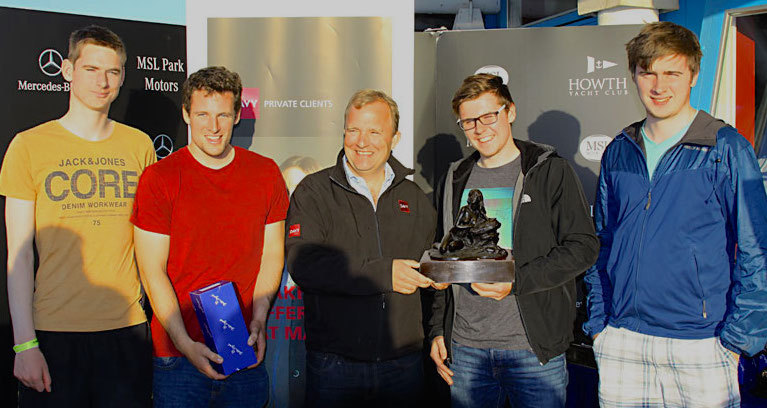
The highly-competitive Class 2 fleet saw Dave Cullen's half-tonner Checkmate XV emerge victorious in IRC to win the Heineken Trophy and Dermot Skehan's Toughnut finished ahead of Colm Birmingham's Bite the Bulletin the ECHO division. In Class 1, it was business-as-usual for Pat Kelly and the team on his J109 Storm, winning the Juno Cup for IRC as well as the Longyearbyn Trophy for best Howth boat, while the Boyd Cup for ECHO went to the Breen/ Gregory/ Hogg team on Flashback.
Other special trophies included the Whelan Cup for the leading Beneteau First 31.7 which was won by C'est la Vie, The Knights Trophy for J24s was won by the other K25 Squad in Johnny Bravo and the E-Boat prize went to Pat O'Neill's OctopussE.
On the Inshore Course, PRO Susan Cummins ensured that the Puppeteers, Squibs and Howth Seventeens got their money's worth with almost 3 hours of racing in the superb weather and conditions. Alan Pearson's Puppeteer Trick or Treat managed to get a valuable win which put his boat on top of the Scratch division, while a win by Gerry Kennedy's Schiggy closes the gap to 3 points from Handicap division leader Yellow Peril. The ISA Sailfleet J80s miss racing for this and next week because of their date with the All Ireland Helmsmans Championships in the NYC next weekend. In the Squibs, Jeff Kay's Chatterbox won the scratch prize for a second week in a row and shares top spot in the Handicap division with Roxanne.
In the Howth Seventeen class, Peter Courtney's Oona crossed the line first with only 30 seconds remaining before the time limit and the resulting time extension enabled all but previous series leader 'Isobel' finish the race.
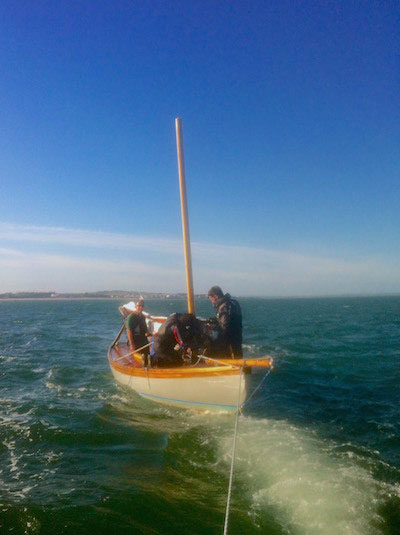
Isobel was unfortunate to be de-masted on the final leg
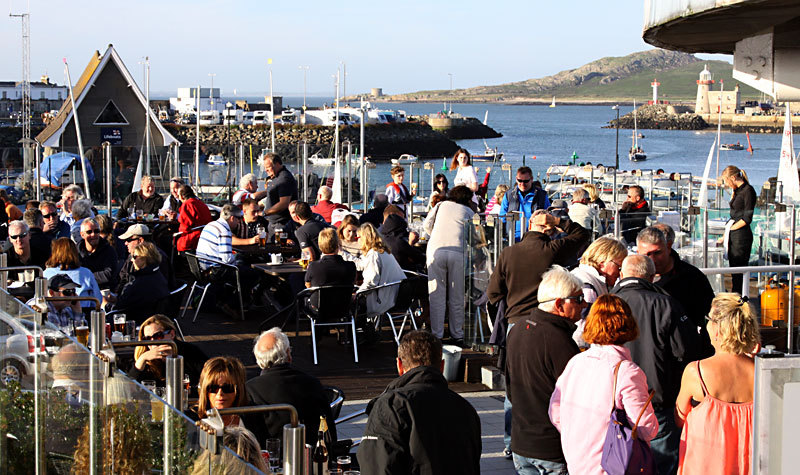
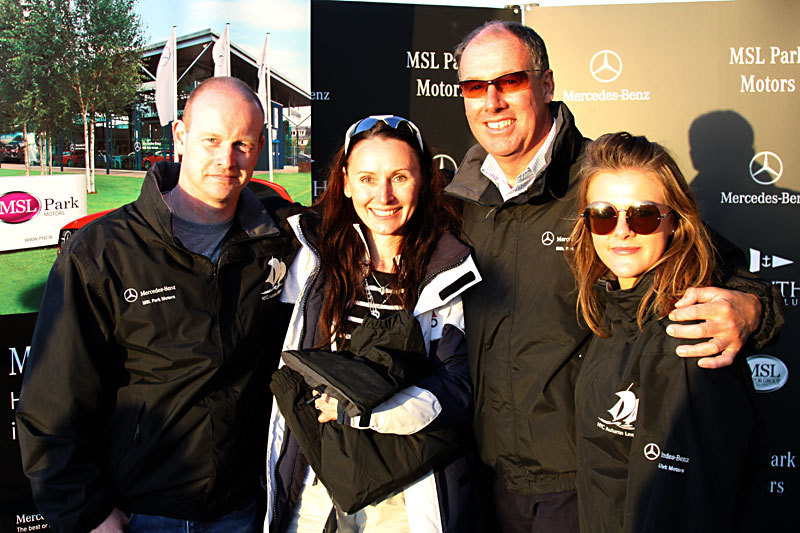
Local Sailing Class Success Takes Good Boats, But Even Better People
As we near the end of the traditional sailing season, inevitably there’ll be heart-searching among boat owners as to the success and value obtained from their summer afloat – can they really justify the expense of continuing to keep a boat? And with so many imponderables in our sport after a summer which was decidedly mixed in its weather - to say the least - the larger sailing community will be scrutinising those classes which seem to be barely hanging in, those classes which are doing quite well, and those few classes which are spectacularly successful. W M Nixon takes a look at the International Dragons in Glandore, the Flying Fifteens in Dun Laoghaire, and the Puppeteer 22s in Howth to try and find that magic Ingredient X which helps - or has helped - these three very different examples to stay ahead of the game.
The wish to own a boat is a vocation, a calling, a quasi-religious emotional endeavour. It’s all very well for high-flown consultants to tell us that if sailing is going to have general appeal and expand, then publicly-accessed freely-available try-a-sail boats will have to be based at every major club. But dedicated sailors know that what comes easy, goes easy. A spell of bad weather, and your jolly public groups who turned up in droves for a bit of free fun afloat will disappear like the will-o’-the-wisps they were in the first place, seeking instead to find somewhere warm and bright and out of the rain and readily providing the latest novel form of entertainment.
Meanwhile, those who are dyed-in-the-wool boat addicts will have barely noticed the idly-interested strangers coming and going. For whatever the weather, they’ve a boat to maintain, gear to repair, a crew to keep together, and some sensible purpose to find in order to give it all deeper meaning. For they know that unless they’ve a boat and her problems and possibilities occupying a significant part of their mind, they’re going to lose the plot completely.
Nevertheless, in the huge spectrum of boat ownership and sailing classes, why is there so much difference in the successful buzz created by some classes at certain localities, as opposed to the dull and declining murmur emanating from classes which are clearly on the way out?
After all, there are very few utterly awful boats afloat. No boat is completely perfect, though some may seem less imperfect than others. But in today’s throwaway world, if some class of boat is not a reasonably good representative of her general type, then she’ll never make the grade in the first place. And even in times past when news and views moved more slowly, the word soon got around if some much-touted type of boat was in truth a woofer.
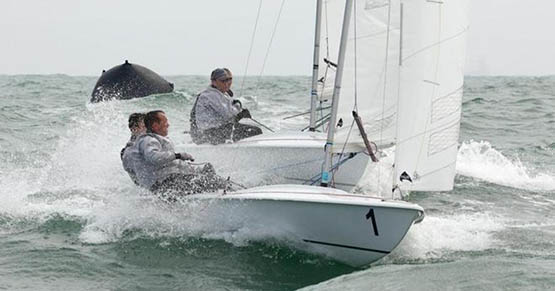
Flying Fifteens provide the best of sport in a very manageable two-man package

The perfect harbour for vintage International Dragons – Glandore, with a goodly selection of classics in port, and Dragons of all ages dotted among them
That said, boat-owning is such an all-consuming passion that once a sailor has finally (or indeed hastily) committed to a particular boat type, then he or she will tend to be absurdly dismissive of any remotely comparable craft. But in the last analysis, the desire to own a boat is irrational. So we shouldn’t be surprised that once the decision is made, irrational attitudes manifest themselves in every direction.
And anyway, as John Maynard Keynes once remarked in a totally different context, in the last analysis we are all dead. So in the meantime, it behoves us to get as much reasonable enjoyment out of life as possible. Thus if owning and sailing a boat is your way of obtaining pleasure without harming anyone else, then good luck to you and me, and let’s look together at boat classes which are doing the business.
In considering the International Dragons in Glandore, the International Flying Fifteens in Dun Laoghaire, and the emphatically not-international Puppeteer 22s in Howth, we are indeed casting the net wide, for really they couldn’t be more different. The 29ft International Dragon originated in the late 1920s from the design board of Johan Anker of Norway, and she has become a by-word for Scandinavian elegance in yacht design, but today she’s totally a racing machine and has strayed far from her original concept as a weekend cruiser for sheltered waters.
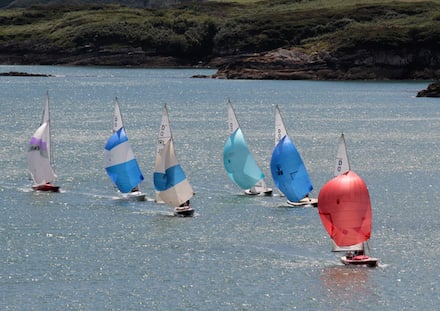
Golden days of classic Dragon racing at Glandore
As for the Flying Fifteen, they originated from designer Uffa Fox having a brainstorm in 1947, in that he took the underwater hull section of the renowned International 14 dinghy in which he was something of a master both as designer and sailor, but above the waterline he drew out the bow to an elegant curved stem, then he lengthened the gentle counter lines to finish in a long sawn-off transom. That done, he added a little hyper-hydrodynamic bulb ballast keel which seemed very trendy, but in truth it’s severely lacking in useful lateral resistance. Nevertheless it gives the boat the reassuring feel of being a small keelboat rather than a big dinghy, and atop it all he put the rig of an International 14 dinghy of that era.
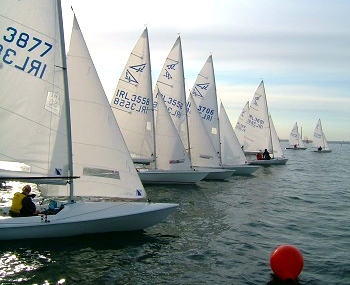
The clean lines of a modern Flying Fifteen fleet. Try to imagine that within each hull there’s an International 14 dinghy, and above it is the original rig
The result was a boat which is really only useful for racing, and it is a design so much of its times that it’s said that many years later the designer himself tried to disown it. But the owners would have nothing to do with this, they liked the compact and very manageable racing-only package which the Flying Fifteen provides, and these days the class has an interesting world spread, and an attractive policy of staging their World Championships at agreeable sunshine destinations where – thanks to their guaranteed ability to turn up with a fleet of viable size – they can arrange block discounts to provide the owners with a very appealing package.
After the sheer internationality of the Dragons and the Flying Fifteens, the Puppeteer 22s are something of a culture shock, as almost every one in existence has ended up based in Howth, where they have such a busy club programme that they only very seldom go south of the Baily, though they do have one annual adventure to Malahide for the Gibney Classic, and once a year they take part in the historic Lambay Race. But otherwise, they’re totally and intensely focused on club racing off Howth.

The Puppeteer 22s seldom stray far from their home port of Howth, for at home they get superbly close racing with a fleet of up to 26 boats in evening racing. This is former ISA President Neil Murphy racing hard at the helm of Yellow Peril, neck and neck with Alan Pearson’s Trick or Treat. Photo: W M Nixon
They were designed by Chris Boyd of Strangford Lough in the mid 1970s to be fractionally-rigged mini-offshore racers, and in all about thirty-three of the Puppeteer 22s were built by C & S Boyd in Killyleagh (Sarah was Chris’s wife). For a while it looked as though they might take off as a semi-offshore One Design class in the north, but somehow they began to trickle down to Howth. They appealed to those sailors who felt that the alternative of a Ruffian 23 with her huge masthead spinnaker was a little too demanding on crews, whereas the Puppeteer’s fractional rig is fairly easily managed. And today the class in Howth is in such good health that even in the poor weather of 2015 they were obtaining regular midweek evening racing best turnouts of up to 26 boats.
Obviously the Puppeteer 22s are now very much a completely localised phenomenom. But while the Flying Fifteens in Dun Laoghaire and the Dragons in Glandore may be representatives of well-established international classes, the fact is in both cases their neighbourhood success is largely due to a distinct local flavour driven by individual enthusiasm. And in Glandore while it’s recognized that the vintage Dragon class was started by Kieran and Don O’Donohue with the classics Pan and Fafner, the man who beats the drum these days for the racing at Glandore as providing “the best and cheapest Dragon racing in the world” is the inimitable Don Street.
Most people will expect that they will be slightly older than the boats they own, and the older you get the greater you’d expect the age gap to be. But Don’s classic Dragon Gypsy is 82 years old. Yet Don himself manages to be that proper little bit senior to her, as he’s 85 and still full of whatever and vinegar, as they’d say in his native New England.
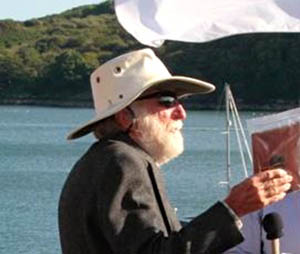
The one and only Don Street in his beloved Glandore. His International Dragon Gypsy is 82 years old, but he still manages to be the senior partner at 85.

Conditions are pleasantly sheltered for the Dragons in Glandore Harbour, but when the fleet goes offshore – as seen here for last year’s championship - they can find all the breeze and lively sea they might want, and more.
The things that Don has done with Gypsy – between intervals of the renowned ocean voyaging with his 1905-built yawl Iolaire which he has now sold – are remarkable, as he sailed Gypsy from Glandore to the classic regatta in Brittany, which is a prodigious offshore passage for an open cockpit racing boat along what the rest of the world would see as significant portions of the most exposed parts of the Fastnet Race course.
Yet although he did such wonderful business with Gypsy on great waters, he has no doubt that the secret of Glandore Dragon racing’s local success is the sheer nearness and convenience of it all. “Down to the pier and out to the boat in five minutes, the starting line is right there, and we don’t race those boring windward-leewards, rather we use club buoys, government navigation marks, islands - and lots of rocks……”
His argument is that with lovely Glandore Harbour being such an fascinating piece of sailing water, part of the interest in keeping up the pace in a local class lies in using those local features, rather than pretending they simply don’t exist by setting courses clear of the land. But of course when the Glandore fleet – which continues as a mix of classic wooden and glassfibre boats – hosts a major event such as last year’s Nationals – which was won by Andrew Craig of Dun Laoghaire in Chimaera – then the courses are set in open water, and they’d some spectacular sailing with it.
In many ways Glandore is a special case, as the population swells in summer with people coming for extended vacations. When that’s the case, their commitment to local Dragon racing can be total, and not least of the occasional local summertime alumni is the great Lawrie Smith. He may have won the Dragon Gold Cup from a fleet of 66 boats last month in Germany under the burgee of another club, but when he’s racing Dragons in Ireland, he’s emphatically under the colours of Glandore Harbour Yacht Club.
Despite these glamorous international links, it’s the folk on the home ground with their dedication to the Dragon Class in Glandore who keep it all going, and it’s Don Street with his dogged determination to prove you can run a Dragon out of pocket money, regardless of the megabucks some might be ready to splash out, which gives the Glandore Dragons that extra something. And in the end it’s all about people, and shared enthusiasm. If you’ve a warm feeling about the Dragon class, and particularly for classic boats in it, then you know that in Glandore you’ll find fellow enthusiasts and every encouragement.
But up in Dun Laoghaire, if you take a look over the granite wall on to the east boat park at the National Yacht Club in summer, and see there the serried ranks of apparently totally identical Flying Fifteens all neatly lined up on their trailers, you could be forgiven for thinking it’s all just ever so slightly clinical, and certainly distinctly impersonal.
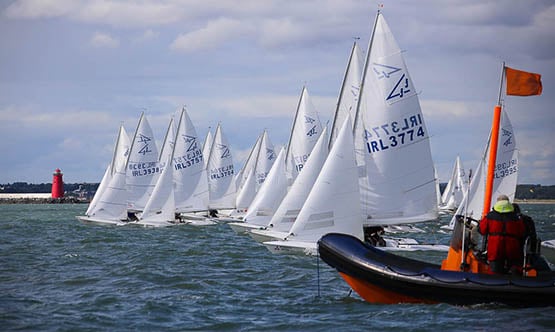
Just about as one design as they could be – the fine fleet at last weekend’s Flying Fifteen Irish Championship in Dublin Bay showed the vigour of the class, which has 47 ranked helmsmen in this country.
Yet you couldn’t be more utterly wrong. Today’s Flying Fifteens may have been technically refined to the ultimate degree to give maximum sport for the minimum of hassle. But their current runaway success – they’re far and away the biggest keelboat One Design class in Dublin Bay – is down to a friendly and very active local class association, and its readiness to reach out the hand of friendship and encouragement to anyone who might be thinking of joining the class’s ranks.
Recently the pace has been set by class captain Ronan Beirne, who recognises that simply announcing and advertising an event is not enough. You have to chivvy people and encourage them into their sailing – particularly after a summer remembered as having had bad weather – and then far from sitting back and smugly counting numbers, you have to keep at it, seeing that crewing gaps are filled, and that those on the fringes are brought to the centre.
The Flying Fifteens – which are essentially a National YC class – offer exceptional value and a very manageable package. The boats are dry-sailed in their road trailers, and instead of queuing for a crane, they have a rapid rota of slip-launching, with the expectation of renewing the wheel bearings each year. Salt water and road trailers are not good partners, but in order to ensure the most efficient launching and retrieval of the boats after each day’s racing, replacing wheel bearings has become something of an art.
The class in Dun Laoghaire secured good sponsorship from Mitsubishi Motors at the beginning of the year, and the sponsors in turn have been rewarded by a thriving class in which inter-personal friendships have developed to such a healthy state that you might find people crewing for someone who would be a complete and untouchable rival at other times in many other classes, but in the Dun Laoghaire Flying Fifteens he’s a fellow enthusiast who happens to be short of a crew on that day.
One of the enthusiastic newcomers to the class this year is Brian O’Neill, who originally hailed from Malahide and was best known for campaigning the family’s Impala 28 Wild Mustard with great success for several years, but now he’s very much a family man living in Dun Laoghaire with three growing kids, and sailing had gone on to the back burner.
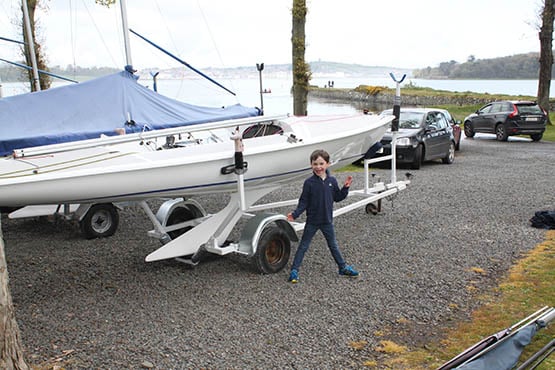
Charlie O’Neill (aged 7) at Strangford SC with dad Brian’s newly acquired Flying Fifteen. Under the rapid moving launching system at the National YC, the dry-sailed Flying Fifteens use their road trailers to get the boats afloat in record time. The need for regular replacement of the wheel bearings is allowed for in each boat’s budget. Photo: Brian O’Neill
But as the National YC is just down the road from where he lives, he was drawn into its welcoming ambience, and soon became aware of the attractive and friendly package offered within the club by the Flying Fifteens. He bought one in good order from an owner at Strangford Sailing Club in the Spring, and was soon in the midst of it. Yet it takes up only a very manageable amount of his time, it simply couldn’t be more convenient, and the people are just great too.
Who knows, but having won the class’s last evening race of the 2015 season, he might even be prepared to travel to maybe one event at another venue in Ireland. But the primary attraction continues to be the class’s strong local ethos and ready racing at the National, the friendliness of fellow Flying Fifteen sailors, and the sheer manageability of the whole thing – this is not a boat where the ownership gets on top of you.
If you want to get the flavour of Dun Laoghaire Flying Fifteen racing, you get a heightened sense of it from the report in Afloat.ie of how David Gorman and Chris Doorly won last weekend’s Irish championship in classic style, and if this isn’t good value in sailing and personal boat ownership, then I don’t know what is.
Across Dublin Bay in those misty waters of Fingal beyond the Baily, your correspondent found himself reporting aboard Alan “Algy” Pearson’s Puppeteer 22 Trick or Treat last Saturday for the opening race of the MSL Park Motors Autumn League. I did so with some trepidation, for Alan has a super young crew recruited from Sutton Dinghy Club in the form of GP14 ace Alan Blay, Ryan Sinnott and Claud Mollard, but our cheerful skipper said that as the day was brisk, they needed the fifth on board for ballast.
In fact, I’d only once raced a Puppeteer before, in the lightest of winds when somehow we managed a win. But as this race progressed with the skipper and his young tacticians making a perfect call for the long beat in a good long course which made full use of the splendid sailing waters north of Howth, by the last leg after many place changes it looked as though another win might be on the cards.

Action stations. Puppeteer 22s closing in for their start. Photo: W M Nixon
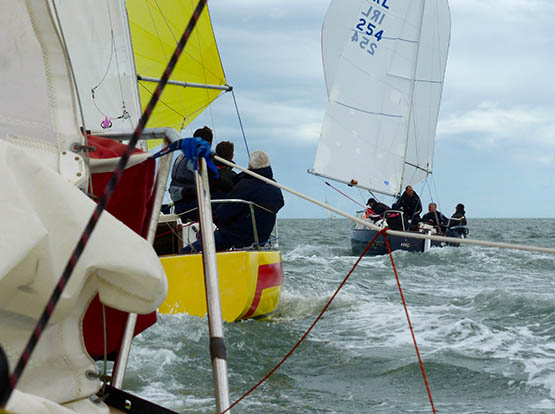
At mid-race, Gold Dust led narrowly from Yellow Peril, but by the start of the last beat, Trick or Treat was leading from Gold Dust with Yellow Peril third. Photo: W M Nixon
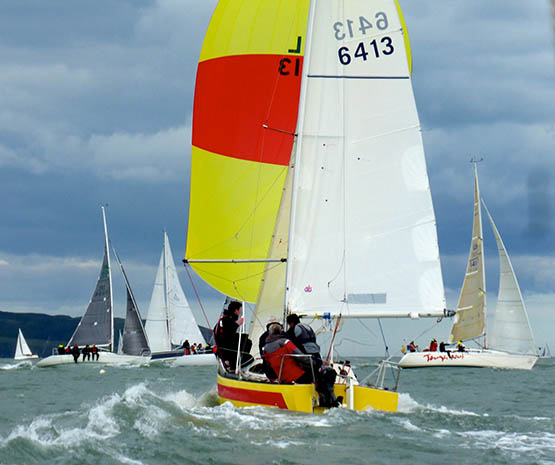
In the MSL Park Motors Autumn League, the mix of classes can sometimes make for interesting situations. Having out-gybed Gold Dust, Yellow Peril is ploughing towards some biggies on another course altogether, and meanwhile there’s the inevitable lobster pot lurking on the way with just one tiny white marker buoy. Photo: W M Nixon
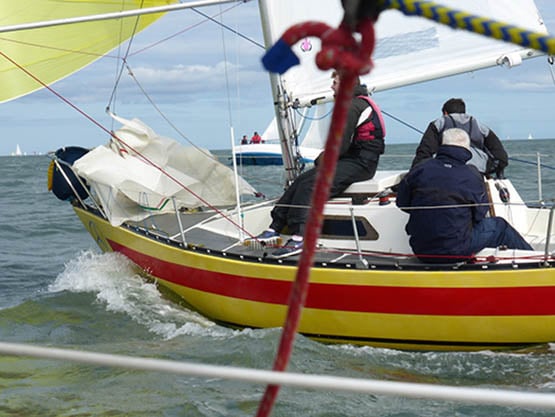
Algy Pearson’s Trick or Treat giving Yellow Peril a hard time to snatch the lead, which she then increased with a cleverly-read long beat. Photo: W M Nixon
But the pace in the Puppeteers is ferocious, and though we’d got a bit of a gap between Trick and former IDRA 14 empress Scorie Walls in Gold Dust, one sneeze from us and Gold Dust would pounce, and alas - we sneezed.
As long as we were carrying the no 2 headsail (what I’d call the working jib) we were level pegging with the formidable Walls-Browne team. But Gold Dust has a lovely new suit of sails (nice ones, Prof), and when the easing wind meant we’d to change up to the genoa, it emerged as a sail of a certain age, and having it set sapped our confidence.
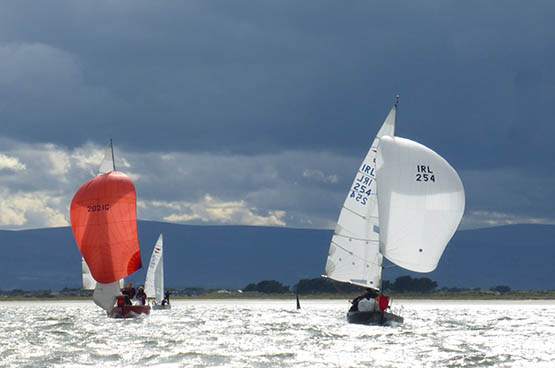
It looked for a while as though Gold Dust (254) had been put fairly comfortably astern……..Photo: W M Nixon
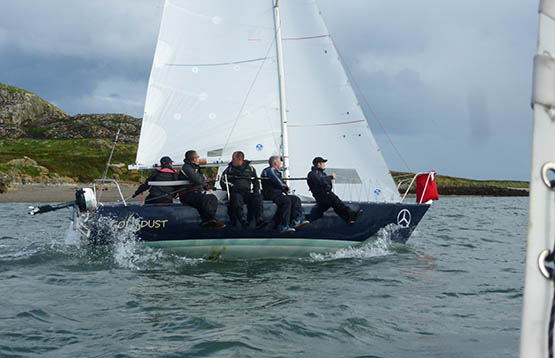
……but an easing of the wind saw Gold Dust finding new speed, and with perfect tactics she was right there with just a hundred metres to go to the finish. Photo: W M Nixon
Until then, the boat had been sailed magnificently, tactics right, trim right, and throwing gybes with such style that the downwind pace never missed a beat. But trying to get that genoa right was a mild distraction, so when Scorie the Queen of the Nile came round the final mark to chase us up the last beat to weather Ireland’s Eye, we’d failed to throw a precautionary tack to keep a loose cover, and suddenly as she rounded she found a local favourable but brief shift of 15 to 20 degrees, and then it was all to play for.
Dissecting it all afterwards (you’ll gather it was a post mortem), we could see two places where we might have still saved the day, but we didn’t grab them, or maybe in truth they were beyond our reach. Whatever, Gold Dust was in the groove and we weren’t. Madam beat us by three seconds. But the banter afterwards and the evidence that Puppeteer people – owners and crews alike – move happily among boats to keep turnout numbers up, was ample proof that here was another truly community based class which perfectly meets a strong local need.

That winning feeling…..Gold Dust’s crew relax after taking first by three seconds. Photo: W M Nixon

The Howth experience. Howth YC Commodore Brian Turvey heads back to port after racing the MSL Autumn League with the Howth 17 Isobel which he co-owns with his brother Conor. Photo: W M Nixon
It had been a great day’s sport, and the Puppeteers being of an age and regularly turning out to race together, they run both a scratch and a handicap system, which is a great improver of local classes – after all, where would golf be without handicaps?
It shows how well Gold Dust has been going this year that her rating is such that we beat her on handicap by one minute and 19 seconds, but we in turn, having been second on scratch, were fourth on handicap, where the winner was the O’Reilly/McDyer team with Geppeto.
Forty years after they first appeared, the Puppeteer 22s are giving better sport than ever, but in a very local context rather than on the bigger stage that might have been anticipated. Yet for their current owners, they do the business and then some. For most folk, this is sailing as it should be. And as to this longterm success of classes which continue to thrive whether they come from a local, national or international background, certainly the quality of the boats is important to some extent. But mostly, it’s the people involved, and their realization that you’ll only get as much out of sailing as you put into it.
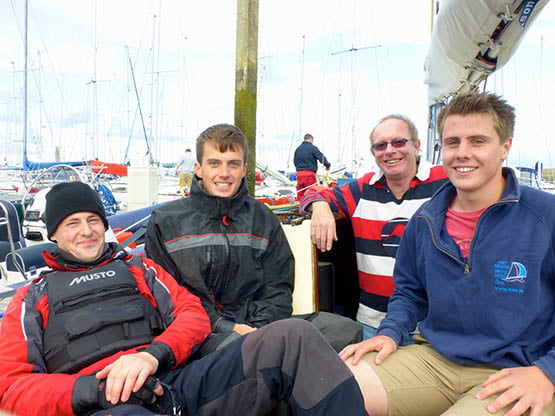
A super crew. Aboard Trick or Treat after racing are (left to right) Alan Blay, Ryan Sinnott, Alan Pearson and Claud Mollard. Photo: W M Nixon

Local man, local boat. Algy Pearson with his Puppeteer 22 Trick or Treat. The Pearsons have been sailng from Howth for three generations. Photo: W M Nixon
Howth Yacht Club's Gilbert Louis Competes At Model Yacht IOM Mortelecque Trophy Regatta
Gilbert Louis (IRL141) from Howth Yacht Club competed at the IOM Mortelecque Trophy regatta in Valenciennes the weekend of the 12th & 13th September and reports here for Afloat.ie
Gilbert joined his brother in France and together made the trip up to Valenciennes arriving after just over 2 hour car journey to a typical French breakfast welcome… Et oui! A coffee with a croissant… hmmmm nice!
Very quickly it was time to rig up the boats, confirm the registration and boat cert before we were out for the first race. It was very well organised.
21 boat which is about the max IOM can realistically sail together. Anything above this and the fleet is broken down into 2 fleets with 4 boats moving each way (top 4 boats from B fleet progressing to A and last 4 of the A fleet going down to B fleet for the next race). This provided for some well disputed starts. And Starts were key to the end result as the top weather mark was not that far.
The IOM class only allows 3 rigs to cover winds up to 30-35 knots. Here there was no question on the choice of rig. Despite a forecast for 11-21 knots we had 6-10 knots max all day, so top rig it was for everyone.
Gilbert races a Goth XP IOM boat designed by Frank Russell Design from Australia, built in wood by our national Irish master-craftsman Neill Suitor from our Northern Ireland fleet. Gilbert was the only wooden boat racing there.
Gilbert found the pace early one with 3 5th place for the first 3 races establishing him in 3rd place after 3 race. But then as the wind got even lighter Gilbert found difficult to find the same pace. Whilst he manage to get in the top 3 a number of time he didn’t manage to finish better then 5th.
After day 1 and 11 races completed Gilbert found himself in 8th place out of 21 boats.
Day 2 was pretty much the same wind but this time coming 180 degree from the Saturday. But as light if not lighter at times. Once again Gilbert didn’t break the top 5 despite once again sail in the top 3 even leading some of the races at times. This was frustrating! His boat was outpointing pretty much everyone else but Gilbert was looking to find speed not pointing and despite making tuning changes between each race only found some marginal speed improvements.
Nonetheless this was a really good experience to gain as Gilbert knows what he needs to work on. A new main with the max draft in different location, a bigger rudder is on the works to try next. And this is part of the tuning when you sail a new design boat. This is part of the fun too!
At the end of day 2 Gilbert had progressed and built a nice gap in 6th place overall. The event was won by Guillaume Florent (Bronze Olympic medallist in Finn class).
100 Entries For First Race of Howth Yacht Club's Autumn League
The first race of this year’s Howth Yacht Club MSL Park Motors Mercedes Benz sponsored Autumn League turned out to be a firm ‘shake-down’ for many of the competitors and their boats this Saturday. The overnight gales had subsided in time for the afternoon starts and almost 100 entries enjoyed lively racing across their nine participating classes in 18-21 knots of wind, flat seas and warm sunshine.
The fresh south-westerly wind enabled the ‘Inshore’ and ‘Offshore’ race management teams set up courses that spanned the full width of the racecourses from the Cush and West marks which are close to the Baldoyle and Portmarnock shores, across to the ‘East’ mark which is positioned north-east of Ireland’s Eye.
The ‘Cruiser’ classes were given a 2-hour race and it was no surprise to see many of the more experienced racing teams finish at the top of each fleet. Pat Kelly’s J109 ‘Storm’ revels in Howth’s annual autumnal keelboat series and emerged victorious in Class 1 while Stephen Quinn’s ‘Lambay Rules’ proved that the team’s recent run of form (including a top spot the Welsh IRC Nationals) will be one to watch in the seriously competitive Class 2 fleet. Other boats racing in this class include Dave Cullen’s ‘Checkmate XV’, the Colwell/Cobbe Corby 25 ‘Fusion’, Anthony Gore Grimes’s ‘Dux’, Michael and Ritchie Evans’s ‘The Big Picture’ and other Half Tonners – Jonny Swan’s ‘Harmony’ and the Kelly/ Boardman owned ‘K1’. The 20 boats entered in this class are all capable of podium positions and many have been champions at other regattas already this year.
Class 3 will see Howth’s K25 team challenge for top spot and affords them the opportunity of rotating their newly expanding team for some competitive racing against the very experienced racers in that Class. The Non-Spinnaker Classes saw a margin of less than a minute separate ‘White Lotus’ and ‘Splashdance’ (Class 4) and a formidable 1,2,3 in Robert Michael’s ‘Mystique’, Harry Byrne’s ‘Alphida’ and Windsor Lauden and Steffi Ennis’s ‘Demelza’ challenge the first race of a very interesting line-up in Class 5.
The ‘Inshore’ classes enjoyed 90-100 minutes racing in the fresh conditions. Alistair Kissane (1st) and Simon Rattigan battled it out on the J80 racecourse, which should see very close racing throughout the series. It was business as usual in the Puppeteer class, where the Walls/Browne partnership in ‘Gold Dust’ started the series with the same determination that won them last year’s overall prize – crossing the finish line 3 seconds ahead of Alan Pearson’s ‘Trick or Treat’. Keeping their powder dry for the remainder of the series, the Squib class boats travelled across the bay to compete in their Eastern Championships this weekend. In the Howth 17 Class race, the average wind speed of just less that 20 knots proved to present a reward for the three boats that dared to fly ‘topsails’, with the respective podium places won by Peter Courtney’s ‘Oona’, the Turvey’s ‘Isobel’ and the ‘Deilginis’ conglomerate.
The series continues next week….



























